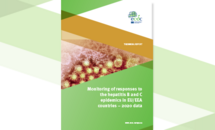Monitoring of responses to the hepatitis B and C epidemics in EU/EEA countries – 2020 data
This report presents findings related to the hepatitis B and C continuum of care, policy on testing and treatment, and the impact of the COVID-19 pandemic on hepatitis services in the EU/EEA from the second data collection conducted in 2021. Data on these topics were collected directly from National Focal Points (NFPs) in 26 of the 30 countries in the EU/EEA. Data on the continuum of care were requested for 2020 or the most recent year with data; data on policy and the impact of COVID-19 reflect NFPs’ views in 2021, during the period of data collection (July–September 2021). The monitoring questionnaire aimed to capture data that would inform progress towards the 2020 WHO European Region Action Plan service targets for the elimination of viral hepatitis. Policy and COVID-19 impact data are presented to provide information on the context and healthcare system environment in which hepatitis services were delivered.
Executive Summary
Beginning in 2016, the European Centre for Disease Prevention and Control (ECDC) developed a monitoring system for hepatitis B and C in the EU/EEA that is aligned with the indicators and targets of the Global Health Sector Strategy (GHSS) and the WHO European Region Action Plan. The primary aims of the system are to support EU/EEA countries in monitoring their responses to the epidemics of hepatitis B and C in a standardised, high-quality manner and to analyse these data and disseminate reports that can guide the European Commission, WHO and other European agencies and organisations to support countries in achieving their goal of hepatitis elimination. An additional aim of the system is to minimise reporting burden by using existing data from other sources where possible.
The first data collection effort for this monitoring system occurred in 2017 and 2018. The second round of data collection took place in 2021, with the aim of collecting standardised, high-quality data that reflected the hepatitis B and C epidemics in 2020 (or the most recent year with available data), aligned with the WHO European Region Action Plan targets for 2020. Six of the 26 European Union/European Economic Area (EU/EEA) countries responding to the 2021 monitoring survey reported no action plan or strategy for viral hepatitis prevention and control. Of the 19 countries which reported a national plan/strategy, only 11 reported that there was national funding for implementation. Twenty-two countries reported that there was testing guidance for hepatitis B and/or C. However, many countries’ guidance did not include one or more of the key populations at risk for hepatitis infections. Three countries reported that not all test costs were reimbursed, nine reported that testing was available in community-based drug service settings and 18 countries reported the existence of policies that require that hepatitis tests be performed by healthcare workers, indicating another policy area that could be revised to allow for improved accessibility of testing. Fourteen of 26 countries reported there were no restrictions on access to treatment for chronic HBV and HCV infection. Of the countries with restrictions on access to treatment, nine identified restrictions for undocumented migrants and three identified restrictions for people who use drugs. Two countries reported that costs for treatment was primarily ‘out of pocket’.
Overall, 20 countries provided data for at least one of the four key stages of the hepatitis B continuum of care and 23 countries provided data for at least one of the four key stages for the hepatitis C continuum of care. The number of countries which were able to report data related to the continuum of care for both hepatitis B and C has fallen since 2018 and significant gaps in data completeness and robustness remain. Data was collected on WHO-defined indicators as well as newly proposed continuum of care indicators. The estimated number of people living with chronic HBV infection by country varied 18-fold from 183 to 3 312 per 100 000 population. However, these estimates were derived from a range of methods of varying quality and were often based on studies from before 2016.
The estimated number of people living with current chronic HCV infection by country ranged 100-fold from 24 to 2 411 per 100 000 population. These estimates were also sourced from a range of methods and most estimates were from 2018 or earlier.
For hepatitis B, it was not possible to assess progress towards the 2020 WHO European Region Action Plan targets for most of the targets due to lack of data. For the 2020 diagnosis target, four of eight countries reporting relevant data had met the 50% target and in terms of viral suppression two countries had met the target of 90% of those on treatment being virally suppressed.
For hepatitis C, data availability along the continuum of care was generally greater compared to hepatitis B but it is still difficult to assess region-wide progress. Four of seven countries reporting relevant data achieved the 50% diagnosed target. The best progress was seen in the HCV sustained virologic response (SVR) target, with ten of the eleven countries reporting data exceeding the 90% target for those achieving SVR of those treated with antiviral medications.
The COVID-19 pandemic had wide-reaching impacts on hepatitis services in the EU/EEA region. It has negatively impacted some hepatitis B and C prevention and testing services. Most countries reported negative impacts of the pandemic on clinic visits for routine care, testing for HBV and HCV, and/or the provision of community-based services. Additionally, 46% of countries reported that there was reduced laboratory capacity for hepatitis B/C testing. However, some routine hepatitis B prevention services, such as routine antenatal screening, were not largely affected by the pandemic. Six countries reported that routine infant/childhood hepatitis B vaccination was negatively affected.
The COVID-19 pandemic did not appear to have a large impact on hepatitis B and C treatment and governmental funding for hepatitis programmes. The pandemic prompted some countries to implement new and innovative strategies, such as virtual appointments and alternative modes of medication delivery.








